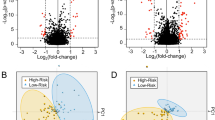Abstract
In this study, we extracted total RNA from 15 intracranial aneurysms and 17 superficial temporal artery samples, then performed genome-wide expression profiling using the Affymetrix U133 Plus 2.0 GeneChip. Genes that were differentially expressed between intracranial aneurysms and arterial samples were identified using significance analysis for microarrays, and the expression patterns of three randomly-selected genes were verified by real-time polymerase chain reaction analysis. We identified 3 736 differentially-expressed genes out of the 47 000 assayed transcripts. A total of 179 genes showed a >10-fold change in expression between the aneurysms and the arterial samples. Genes involved in the proliferation, migration, and apoptosis of vascular muscle cells, atherosclerosis, extracellular matrix disruption, and inflammatory reactions were associated with the formation of intracranial aneurysms. There were no significant differences in gene expression profile between unruptured and ruptured aneurysms.
Similar content being viewed by others
References
Kondo R, Matsumori Y, Kato N, Tsuchiya D, Kokubo Y, Sato S, et al. Trends in the incidence of stroke in Yamagata, Japan. No To Shinkei 2006, 58: 213–218.
Sudlow CL, Warlow CP. Comparable studies of the incidence of stroke and its pathological types: results from an international collaboration. International Stroke Incidence Collaboration. Stroke 1997, 28: 491–499.
Ruigrok YM, Rinkel GJ. Genetics of intracranial aneurysms. Stroke 2008, 39: 1049–1055.
Nahed BV, Bydon M, Ozturk AK, Bilguvar K, Bayrakli F, Gunel M. Genetics of intracranial aneurysms. Neurosurgery 2007, 60: 213–225; discussion 225–226.
Rinkel GJ, Djibuti M, Algra A, van Gijn J. Prevalence and risk of rupture of intracranial aneurysms: a systematic review. Stroke 1998, 29: 251–256.
King JT Jr. Epidemiology of aneurysmal subarachnoid hemorrhage. Neuroimaging Clin N Am 1997, 7: 659–668.
Morgan L, Cooper J, Montgomery H, Kitchen N, Humphries SE. The interleukin-6 gene −174G>C and −572G>C promoter polymorphisms are related to cerebral aneurysms. J Neurol Neurosurg Psychiatry 2006, 77: 915–917.
Fontanella M, Rainero I, Gallone S, Rubino E, Fenoglio P, Valfre W, et al. Interleukin 6 gene polymorphisms are not associated with aneurysmal subarachnoid haemorrhage in an Italian population. J Neurol Neurosurg Psychiatry 2008, 79: 471–473.
Fontanella M, Rainero I, Gallone S, Rubino E, Fenoglio P, Valfre W, et al. Tumor necrosis factor-alpha gene and cerebral aneurysms. Neurosurgery 2007, 60: 668–672; discussion 672–673.
Inoue K, Mineharu Y, Inoue S, Yamada S, Matsuda F, Nozaki K, et al. Search on chromosome 17 centromere reveals TNFRSF13B as a susceptibility gene for intracranial aneurysm: a preliminary study. Circulation 2006, 113: 2002–2010.
Yamada Y, Metoki N, Yoshida H, Satoh K, Ichihara S, Kato K, et al. Genetic risk for ischemic and hemorrhagic stroke. Arterioscler Thromb Vasc Biol 2006, 26: 1920–1925.
Weinsheimer S, Lenk GM, van der Voet M, Land S, Ronkainen A, Alafuzoff I, et al. Integration of expression profiles and genetic mapping data to identify candidate genes in intracranial aneurysm. Physiol Genomics 2007, 32: 45–57.
Kassam AB, Horowitz M, Chang YF, Peters D. Altered arterial homeostasis and cerebral aneurysms: a molecular epidemiology study. Neurosurgery 2004, 54: 1450–1460; discussion 1460–1462.
Marchese E, Vignati A, Albanese A, Nucci CG, Sabatino G, Tirpakova B, et al. Comparative evaluation of genome-wide gene expression profiles in ruptured and unruptured human intracranial aneurysms. J Biol Regul Homeost Agents 2010, 24: 185–195.
Krischek B, Kasuya H, Tajima A, Akagawa H, Sasaki T, Yoneyama T, et al. Network-based gene expression analysis of intracranial aneurysm tissue reveals role of antigen presenting cells. Neuroscience 2008, 154: 1398–1407.
Pera J, Korostynski M, Krzyszkowski T, Czopek J, Slowik A, Dziedzic T, et al. Gene expression profiles in human ruptured and unruptured intracranial aneurysms: what is the role of inflammation? Stroke 2010, 41: 224–231.
Bederson JB, Awad IA, Wiebers DO, Piepgras D, Haley EC Jr, Brott T, et al. Recommendations for the management of patients with unruptured intracranial aneurysms: A Statement for healthcare professionals from the Stroke Council of the American Heart Association. Stroke 2000, 31: 2742–2750.
Schievink WI, Schaid DJ, Michels VV, Piepgras DG. Familial aneurysmal subarachnoid hemorrhage: a community-based study. J Neurosurg 1995, 83: 426–429.
Shi C, Awad IA, Jafari N, Lin S, Du P, Hage ZA, et al. Genomics of human intracranial aneurysm wall. Stroke 2009, 40: 1252–1261.
Kosierkiewicz TA, Factor SM, Dickson DW. Immunocytochemical studies of atherosclerotic lesions of cerebral berry aneurysms. J Neuropathol Exp Neurol 1994, 53: 399–406.
Chyatte D, Bruno G, Desai S, Todor DR. Inflammation and intracranial aneurysms. Neurosurgery 1999, 45: 1137–1146; discussion 1146–1147.
Schwarze U, Schievink WI, Petty E, Jaff MR, Babovic-Vuksanovic D, Cherry KJ, et al. Haploinsufficiency for one COL3A1 allele of type III procollagen results in a phenotype similar to the vascular form of Ehlers-Danlos syndrome, Ehlers-Danlos syndrome type IV. Am J Hum Genet 2001, 69: 989–1001.
Amarenco P. Hypercholesterolemia, lipid-lowering agents, and the risk for brain infarction. Neurology 2001, 57: S35–44.
Keane MP, Strieter RM. Chemokine signaling in inflammation. Crit Care Med 2000, 28: N13–26.
Ruigrok YM, Rinkel GJ, Wijmenga C. Genetics of intracranial aneurysms. Lancet Neurol 2005, 4: 179–189.
Author information
Authors and Affiliations
Corresponding author
Rights and permissions
About this article
Cite this article
Yu, L., Fan, J., Wang, S. et al. Gene expression profiles in intracranial aneurysms. Neurosci. Bull. 30, 99–106 (2014). https://doi.org/10.1007/s12264-013-1398-8
Received:
Accepted:
Published:
Issue Date:
DOI: https://doi.org/10.1007/s12264-013-1398-8




